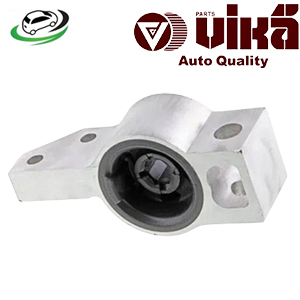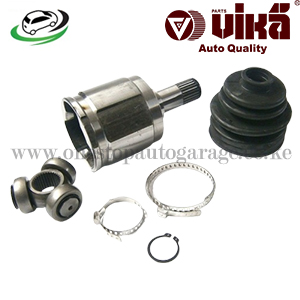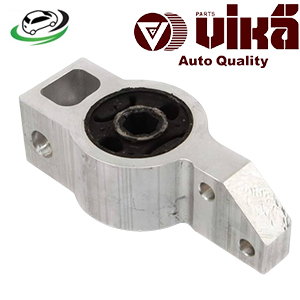-14%
Get Front Right Control Arm Bush AUDI A3 2004-2013 / VW Touran 2003-2010/EOS 2006-2016/Caddy 2004-2020/Toledo 2004-2009 1K0199232G
The control arm bush, often referred to as the control arm bushing, is a crucial element in a vehicle’s suspension system. It acts as a pivot point between the suspension and the vehicle’s frame, providing a smoother and more controlled ride. Here’s an in-depth exploration of the control arm bush, its function, types, common issues, maintenance, and replacement.
Function of the Control Arm Bush
The control arm bush serves several essential functions within the suspension system:
- Dampening Vibrations: It absorbs shocks and vibrations from the road, providing a smoother ride by preventing them from being transmitted to the vehicle’s chassis and passengers.
- Maintaining Alignment: The bushings help maintain the proper alignment of the control arm, ensuring that the wheels remain correctly positioned relative to the vehicle’s frame.
- Allowing Movement: They allow the control arm to move up and down with the suspension while keeping the wheels aligned and stable.
- Reducing Noise: By isolating vibrations, the bushings reduce noise from the suspension, contributing to a quieter ride.
Types of Control Arm Bushes
Control arm bushes come in various designs and materials, each tailored to specific performance requirements:
- Rubber Bushes:
- Material: Made from rubber compounds.
- Pros: Good balance of flexibility and durability, excellent vibration absorption.
- Cons: Can wear out over time, especially when exposed to oil, heat, or extreme conditions.
- Polyurethane Bushes:
- Material: Made from polyurethane.
- Pros: More durable than rubber, better resistance to chemicals and heat, improved handling and performance.
- Cons: Can be stiffer, leading to a harsher ride and increased noise.
- Solid Bushes:
- Material: Made from solid metal or metal-reinforced materials.
- Pros: Extremely durable, provide precise handling.
- Cons: Transmit more road noise and vibrations, less comfortable ride.
Importance of the Control Arm Bush
The control arm bush is vital for several reasons:
- Ride Comfort: By absorbing shocks and vibrations, it enhances ride comfort and reduces fatigue for passengers.
- Handling and Stability: Properly functioning bushings help maintain vehicle stability and handling, especially during cornering and braking.
- Component Protection: They protect other suspension components from excessive wear and damage by reducing vibrations and shocks.
- Safety: Maintaining proper alignment and stability of the wheels ensures safe driving conditions, preventing issues such as uneven tire wear and loss of control.
Common Issues with Control Arm Bushes
Over time, control arm bushes can develop issues that affect their performance:
- Wear and Tear: Continuous exposure to road conditions, heat, and contaminants can cause the bushings to degrade and wear out.
- Cracking and Splitting: Rubber bushings can crack or split due to age, extreme temperatures, or exposure to oils and chemicals.
- Noise and Vibration: Worn or damaged bushings can lead to increased noise and vibrations, indicating that they need replacement.
- Misalignment: Worn bushings can cause the control arms to misalign, leading to uneven tire wear and handling issues.
Signs of Failing Control Arm Bushes
Recognizing the signs of failing control arm bushes can help prevent more severe suspension issues:
- Noise: Clunking, knocking, or creaking noises from the suspension, especially when going over bumps or during braking and acceleration.
- Vibrations: Increased vibrations felt through the steering wheel or the vehicle’s body.
- Poor Handling: Difficulty in steering, especially during turns, and a feeling of looseness or instability.
- Uneven Tire Wear: Abnormal or uneven tire wear patterns, indicating alignment issues due to worn bushings.
- Visual Inspection: Visible cracks, splits, or excessive movement in the bushings upon inspection.
Maintenance and Prevention
Regular maintenance can help ensure the longevity and effectiveness of control arm bushes:
- Regular Inspections: Check the bushings for signs of wear, cracks, or damage during routine maintenance or whenever unusual symptoms are noticed.
- Clean Surroundings: Keep the suspension components clean to prevent debris and contaminants from accelerating wear.
- Proper Lubrication: For polyurethane or other non-rubber bushings, ensure they are properly lubricated to prevent squeaking and reduce wear.
- Replace as Needed: Replace the bushings at the first sign of significant wear or damage to maintain optimal suspension performance.
Replacement of Control Arm Bushes
Replacing control arm bushes can be a complex process, but it is essential for maintaining suspension integrity. Here’s a general guide:
- Preparation:
- Tools and Materials: Gather necessary tools, including a jack, jack stands, wrenches, and the replacement bushings.
- Safety Measures: Ensure the vehicle is on a level surface and securely supported on jack stands.
- Remove Control Arm:
- Raise Vehicle: Lift the vehicle and remove the wheel to access the control arm.
- Disconnect Control Arm: Remove any bolts or fasteners connecting the control arm to the suspension and frame.
- Remove Old Bushings:
- Press Out Bushings: Use a bushing press or appropriate tool to press out the old bushings from the control arm.
- Clean Control Arm: Clean the bushing housing in the control arm to remove any debris or corrosion.
- Install New Bushings:
- Press In New Bushings: Use the bushing press to carefully press the new bushings into the control arm.
- Lubricate: Apply the recommended lubricant to the new bushings if required, especially for polyurethane types.
- Reinstall Control Arm:
- Reconnect Control Arm: Reattach the control arm to the suspension and frame, ensuring all bolts and fasteners are securely tightened to the manufacturer’s specifications.
- Lower Vehicle:
- Refit Wheel: Reattach the wheel and lower the vehicle to the ground.
- Test Drive: Take the vehicle for a test drive to ensure proper handling and check for any unusual noises or vibrations.
Follow us on Facebook for more parts.



